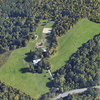Bronx speaker takes in scenes and scents at Indian Ladder Farms
NEW SCOTLAND — As Peter Ten Eyck, who owns Indian Ladder Farms, waited Thursday afternoon for the State Assembly speaker to arrive at his farm, he had a clear idea of what he’d like Carl Heastie to see.
“I want him to see modern food being grown by the latest technology. I want him to know we’re going to win; we’re going to beat the factory farms,” he said.
Ten Eyck’s 100-acre farm, which stretches along both sides of Route 156 under the Helderberg escarpment, produces apples and berries. It is one of two remaining orchards left in Albany County, serving as a draw for tourists.
Ten Eyck’s grandfather, a congressman and state agricultural commissioner, founded the farm in 1916. “It was more of a country-gentleman thing,” Peter Ten Eyck said of his grandfather and father’s role on the farm.
The farm has been a lifetime of work for Peter Ten Eyck, who will turn 77 this month. He left to earn a degree at Cornell’s agricultural college and to serve in the Army, as a guided missile repairman, but otherwise has been hands-on at Indian Ladder Farms.
After the farm’s dairy barn burned in 1949, “Dad got beef cattle,” said Ten Eyck. “I took over in ’65 and thought, ‘Why try to farm something that moves?’” The farm now has thousands of apple trees. The only thing that moves are the visitors.
“We get 5,000 or 6,000 on one day in the fall,” said Ten Eyck.
He went on as he waited for Heastie, “I want him to get exposure to things that actually grow — we grow our own food in the fabric of the community. That’s what this is all about,” Ten Eyck said, gesturing widely to the orchards around him.
Ten Eyck, who served for a dozen years as a Cornell trustee, said, “We’re trying to keep agriculture viable. We have to empower small to medium farms to be productive. Americans have to stop waving money in the air and hope someplace else in the world will meet their needs.”
He also said, “We have to have not just sustainable farming but sustainable cuisine. People who eat have to take responsibility for how things are grown.”
To succeed as a small farmer, Ten Eyck said, “You’ve got to be a destination place. You’ve got to be in the entertainment business.” He explained, “People eat four or five times a day for a recreational experience; it’s not to sustain themselves.”
People come to his farm by the droves in the autumn, seeking some primal connection with harvest. Ten Eyck said of human beings, “We have a sense we want to be centered on something fundamental and profound — to stand in an orchard and look at the mountains.”
As he waited, Ten Eyck hoped Heastie, who is from the Bronx, would have that experience.
Heastie was elected the Assembly speaker in February after the long-time speaker, Sheldon Silver, was arrested on federal corruption charges. He has been making a tour of upstate New York, visiting Binghamton, Buffalo, Syracuse, and Utica among other places.
Local Assemblywoman Patricia Fahy helped organize Heastie’s Capital Region tour and said it was the first time in memory a speaker had made an upstate tour.
Heastie arrived at the farm, with several staffers, in a black Jeep SUV. “This is a legend,” said Fahy, introducing Ten Eyck to the speaker.
Ten Eyck offered Heastie a seat in his open-air farm vehicle to take him to an orchard. Heastie who wore dark trousers and a white shirt with golden cufflinks and a blue necktie was feeling the heat as the temperature topped 90 degrees and the air was heavy with humidity.
Fahy took the seat up front in Ten Eyck's rig as an Associated Press photographer and an Enterprise reporter hopped in back for an open-air, bouncy ride to the orchard while Heatsie and his crew rolled over in the SUV, windows closed to keep the cool air in.
Once in the orchard, Ten Eyck pointed out large old apple trees, contrasting them with the new trees — bearing snapdragons — shorter than a man and much closer together than the big old trees, making the fruit easy to harvest.
“Whoever grows up gets all the energy,” said Ten Eyck, explaining the growing technique to Heastie, as the two men stood by a long row of small trees, each tied to a pole.
“This is a New York apple, a Cornell apple,” said Ten Eyck of the snapdragon.
“Where do the green apples grow?” asked Heatsie. “I’m a green-apple person.”
“These will be green till they get red,” said Ten Eyck. “Red is a function of cold nights and sunny days...Redness has nothing to do with ripeness.”
“What are those over there?” asked Heastie, pointing to a long white plastic cover on a distant field.
“Raspberries,” responded Ten Eyck, explaining that his farm eschews pesticides, and the cover keeps the berries from getting wet.
With that, the tour crossed Route 156 where Ten Eyck’s daughter, Laurie, and her husband Dietrich Gehring, are growing hops to make beer; they’ll also make hard cider.
Laurie Ten Eyck, a one-time Enterprise reporter, has written a book about hops (see related story) and she works for the American Farmland Trust as the senior manager of New York projects and outreach. The trust lobbies for farmland protection, “keeping it from housing developments,” said Laurie Ten Eyck.
Although hops production is now a fledgling business in the state, Laurie Ten Eyck told Heastie as they walked toward rows of tall poles covered with hop vines, “New York used to be the biggest provider of hops.”
She plucked some of the hops from a vine so that the visitors could smell them. “That’s what gives beer its distinctive flavor,” she said as Fahy and Heastie held the small green buds up to their nostrils.
“I’m bringing this home,” exclaimed Fahy, noting her husband likes beer.
“Last year, we picked by hand,” said Laurie Ten Eyck. “It was really, really bad...It takes one person an hour to pick one vine. Now we have a mechanical harvester. We just got it running yesterday,” she said of the $25,000 machine. “We’ll make our own beer and hard cider.”
“How much beer can one of these make?” asked Heastie.
“I knew you were going to ask that,” responded Laurie Ten Eyck.
“I’m a mathematician,” said Heastie; with degrees in math and finance, he had worked as budget analyst for the New York City Comptroller before being elected to the Assembly in 2000.
Laurie Ten Eyck held out a cupped hand filled with hops and said that amount would make a batch of home brew. “The bulk of beer is water and barley. This is for flavor,” she said of the hops.
“We don’t have a lot of support,” she said of those growing hops and making beer in New York State. “Right now, people are drying them in barns on screens.”
But, she concluded, while local farmers don’t have the high-tech equipment of growers in the Pacific Northwest, “Farmers are really ingenious...Everyone is helping each other.”
The last stop on the Indian Ladder tour was at the barn that houses the Yellow Rock Café.
“You want some cider and doughnuts?” asked Laurie Ten Eyck.
“I shouldn’t,” responded Heastie, patting his belly.
But, once seated in the café, he reached for a sugared doughnut, bit into it, and said, “This is great.”
As he ate, Laurie Ten Eyck sat beside Heastie, telling him about the spring of 2012. “As a consequence of climate change, the trees blossomed in March,” she said. “Then, when the weather dropped down to normal, all the blossoms froze,” ruining the apple crop that year.
“Do you have crop insurance?” asked Heastie.
“Yes we do,” said Laurie Ten Eyck. “All the people come here to pick apples...We took that money to have apples here for them. We didn’t want people to get out of the habit.”
Asked what he learned on his tour, Heastie told The Enterprise, “As much as people try to talk about differences in different parts of the state, most people care about the same things...education, infrastructure, and, in urban centers, poverty.”
He also said, “It’s been great just to take in how beautiful it is. Some of these rides have been eye-popping.”
Asked how he felt about Heastie’s tour, Peter Ten Eyck said, “The fact he would take the time to come to a place like this — there are no votes here, there is nothing in it for him except to learn — I think that’s something.”
Heastie had the last word: “I’ll bring my daughter up here in the spring,” said the speaker.


